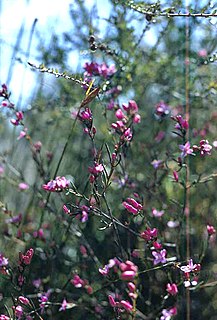
Eremophila brevifolia, also known as spotted eremophila, is a flowering plant in the figwort family, Scrophulariaceae and is endemic to the south-west of Western Australia. It is an erect, open, spindly shrub with sticky, short, serrated leaves and white to pink flowers and is only known from a few scattered populations.

Boronia megastigma, commonly known as brown boronia, sweet-scented boronia or scented boronia, is a plant in the citrus family Rutaceae and is endemic to the south-west of Western Australia. It is a slender, erect shrub with aromatic leaves and flowers, the leaves with three or five leaflets and the flowers cup-shaped, dark brown to purplish black on the outside and yellow inside.

Boronia molloyae, commonly called the tall boronia, is a plant in the citrus family that is endemic to coastal regions in the south-west of Western Australia. It is a shrub with pinnate leaves that mostly have between three and seven leaflets, and deep rose pink, four-petalled flowers. It usually grows along streams in sandy soil.

Eremophila glabra subsp. albicans is a plant in the figwort family, Scrophulariaceae and is endemic to Western Australia. It is similar to other shrubs in the species Eremophila glabra but it distinguished from them by its usually grey, felty leaves, dull yellow, orange or red flowers with hairy sepals, growing in sandy soils on dunes and limestone outcrops between Bunbury and Shark Bay.

Boronia coerulescens, commonly known as blue boronia, is a plant in the citrus family, Rutaceae and is endemic to southern Australia. It is a small, spindly shrub with glandular stems, small, more or less cylindrical leaves and blue to pinkish mauve, four-petalled flowers. There are two subspecies endemic to Western Australia and a third that also occurs in three eastern states.

Boronia fastigiata, commonly known as bushy boronia, is a plant in the citrus family, Rutaceae and is endemic to the south-west of Western Australia. It is an erect shrub with small leaves and small groups of red, pink or purple, four-petalled flowers near the ends of the branches.

Boronia gracilipes, commonly known as karri boronia, is a plant in the citrus family, Rutaceae and is endemic to the south-west of Western Australia. It is an erect, spindly shrub with compound leaves and pink, four-petalled flowers.

Boronia juncea is a plant in the citrus family, Rutaceae and is endemic to the far south-west of Western Australia. It is an erect shrub with linear, short-lived leaves and groups of up to eight white to pink, four-petalled flowers.
Boronia corynophylla is a plant in the citrus family, Rutaceae and is endemic to a small area in the south-west of Western Australia. It is a spreading shrub with thin, simple, cylindrical to narrow club-shaped leaves and pale red, four-petalled flowers in groups of up to three on the ends of the branches.

Boronia capitata, commonly known as the cluster boronia, is a plant in the citrus family, Rutaceae and is endemic to the south-west of Western Australia. It is a slender, spreading shrub with simple leaves and pink, four-petalled flowers.

Boronia crassifolia is a plant in the citrus family, Rutaceae and is endemic to the south-west of Western Australia. It is a small, slender shrub with pinnate leaves, and yellowish green to brownish, four petalled flowers.

Boronia defoliata is a plant in the citrus family, Rutaceae and is endemic to the south-west of Western Australia. It is a straggly shrub with simple, thread-like leaves and white to pink, four-petalled flowers that are pale blue on the back.
Boronia interrex, commonly known as the Regent River boronia, is a plant in the citrus family, Rutaceae and is endemic to a small area in the Kimberley region of Western Australia. It is an erect, sometimes low-lying shrub with pinnate leaves, cream-coloured to pale pink sepals and pink petals, the sepals longer and wider than the petals.

Boronia nematophylla is a plant in the citrus family Rutaceae and is endemic to the south-west of Western Australia. It is a shrub with thin, simple leaves and pale red to purple, four-petalled flowers arranged singly or in small groups in leaf axils.

Boronia ovata is a plant in the citrus family, Rutaceae and is endemic to the south-west of Western Australia. It is an open shrub with simple, egg-shaped leaves and pink to mauve four-petalled flowers. It is found in the Darling Range near Perth.

Boronia ramosa is a species of plant in the citrus family Rutaceae and is endemic to the southwest of Western Australia. It is an erect, mostly glabrous shrub with pinnate leaves with up to seven leaflets, and white, four-petalled flowers with blue or pale green backs.

Boronia stricta is a plant in the citrus family, Rutaceae and is endemic to near-coastal areas of the south-west of Western Australia. It is a slender shrub with often crowded pinnate leaves with linear leaflets, and pink, four-petalled flowers borne singly or in groups of two or three in leaf axils.

Boronia tenuior is a species of flowering plant that is endemic to Western Australia. It is an open shrub with thin, square stems, simple, serrated leaves, and pink to mauve, four-petalled flowers.

Boronia virgata is a plant in the citrus family, Rutaceae and is endemic to the south coast of Western Australia. It is a virgate shrub with pinnate leaves with between three and five leaflets, and flowers with red sepals and deep pink, egg-shaped petals.

Boronia westringioides is a species of erect shrub that is endemic to a small area in the southwest of Western Australia. It has simple, narrow, sessile leaves and pale pink flowers arranged singly in leaf axils.



















